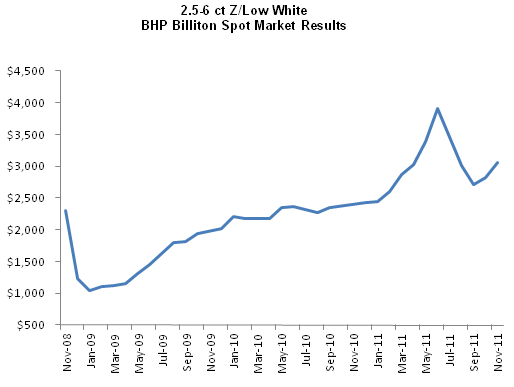IDEX Online Rough Report: It Was the Best and Worst of Times (Updated)
December 22, 11
(IDEX Online News) – The tumultuous story of rough diamonds in 2011 reflected the wild and twistful events of the year – in economy and global politics. Prices shot upwards only to fall,
The rollercoaster ride in the price of BHP Billiton's 2.5-6 ct Z/Low White can best symbolize the vicissitudes of the rough sector in 2011.

This usually high demand selection, which sold for $1,226 per carat at BHP Billiton's Spot Market auction in December 2008, doubled in price to $2,446 p/c in January 2011, peaked at $3,395 p/c in May, dropped to $2,711 p/c at the September auction only to rise again to $3,066 p/c at the November auction.
The sharp change in the direction of this item's price came as the first seven months of 2011 were a restocking and speculation stage. Large demand by retailers in
Traders bought goods and sold them quickly, making very quick and very large profits in the process. This speculative behavior boded well as long as prices continued to rise.
This all ended in August. Liquidity and financing issues in
Oddly, this was a sign of health in the sector. Rough prices followed those of polished, and did not act independently. As Chinese and Indian retailers slowed their polished diamond purchases, so did diamond traders. The decrease in polished prices was quick to follow, and rough prices reacted in sync.
Those holding to rough diamond stocks suddenly found that they could sell the goods only at a loss.
Contracted first hand buyers – DTC Sightholders, Long Term Alrosa clients, BHP Billiton Term Market customers and Rio Tinto Select Diamantaires – continued buying, but found that there was no demand for the goods in the secondary market, leading to rough selling at a loss of 1-10 percent – if they found a buyer.
First hand buyers continued buying, wanting to demonstrate to their banks that they are maintaining their turnover as well as show their suppliers that they are good clients.
Last Cycle of the Year Subdued
With few exceptions, DTC prices at Sight 10 in December were down a few percents. The Collection 2.5-4 carats box sold for $4,210 p/c, a 4 percent decrease; Fine 2.5-4 carats sold for $3,188 p/c, down 6.8 percent and the Chips 4-8 grainers were offered at $994 p/c, a 0.5 percent decrease.
Sightholders said the assortments were less good, making it unclear how much the prices were really decreased. The mentioned prices are those of the miners.
On the secondary market, while there are more buyers, goods often sell at about 1 percent below the DTC list price. The high 20+ percent premiums made in the first half of the year are a sweet, yet fading memory.
Demand for boxes in the secondary market, as shown in table 1, is still limited, though a certain improvement is noted.
The 10.8+ carat diamonds, AKA the Specials, were priced very high, according to Sightholders, some of them complaining bitterly about it.
The Sight was small as expected, estimated at $430-$450 million.
At BHP Billiton's Spot Market, prices were up on average by a high single percent for the 2.5-6 carat items (see table 2), sending a possible early sign of renewed interest in rough.
Alrosa is still the pricey source of goods.
Outlook
Retail sales during the November – December holiday period will have a strong impact on rough diamond demand in the first quarter of 2012.
With high enough diamond jewelry sales, retailers will turn to replenish their stocks, driving polished sales and then rough sales. The one issue to keep in mind is the polished stock levels held by wholesalers. If they are as high as we hear they are, traders will not need a large supply of rough to meet polished demand.
In the longer term, the rough sector is highly dependent on the global economic mood.
Demand for DTC key Boxes after Sight 10
|
BHP Billiton November-December Spot Prices*
Table 2 *All BHP Billiton price data collected from third parties |
(Updated December 23, 2011 12:57. Corrected erroneous October figures in Table 2.)